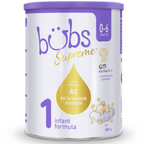How to Change Baby Formulas
Regardless of the reason, learning how to change baby formula is a process that requires a lot of care and consideration. To make your life easier, we have compiled a guide to changing formula, including signs you should consider switching, how to actually change, side effects to look out for, as well as any tips to make the process as smooth as it can be. We recommend speaking with a qualified nurse or healthcare professional before introducing a new formula to understand what your baby’s individual needs are.
Signs to change your baby’s formula
There is no ‘correct’ time or age to change your baby’s formula, but there are some tell-tale signs that you can keep an eye out for that might help you identify the best time to do so. Some common signs that your current formula isn’t agreeing with your baby are diarrhoea, excessive fussiness, gas, increased sleep disruption, rashes, wheezing after eating or vomiting. Every baby is different, so observe their behaviours and take their lead when it comes to which formula works best for them.
How to change your baby’s formula?
Since each baby is different, some may be more receptive to changing formula, others are less willing to drink new formula. While this can be frustrating for parents, it’s important to remember that formulas can vary in taste, consistency and effect on the body, so it is perfectly normal for some babies to become fussy. Whether you are changing brands or changing formula types, for example, from cows milk formula to goats milk formula, the key is to make slow, gradual changes. Introducing a new formula too suddenly can cause babies to get fussy as well as other body complications like constipation. We recommend introducing one bottle of new formula during your baby’s morning feed or at a time when they are hungry. Continue this process for a few days and observe your baby’s cues before transitioning to more meals. For more details on switching formulas, check out our transitioning ratio guide on our FAQ page.
Tips for switching formulas
To help with your journey of switching formula for your baby, here are some top tips to keep in mind:
- Consult with a healthcare professional. Every baby is different and has varying needs.
- Offer new formula in the mornings to avoid your baby being fussy at night.
- Try to keep your feeding environment consistent when you are introducing a bottle of a new formula. This will decrease the chance of your baby getting more confused with too many changes.
Changing baby formula side effects
Potential side effects babies may experience when transitioning between different formulas include:
- Change in bowel movements
- Change in vomiting
- Weight gain or loss
- Increased fussiness around feeding
- Change in sleep patterns
- Rashes
Learning how to switch formula for your baby is not always a straightforward process and can be very challenging at times. This article serves as a guide for new parents navigating the process, but always remember to speak and check with a qualified nurse or healthcare professional before introducing a new formula to understand what your baby’s individual needs are.


